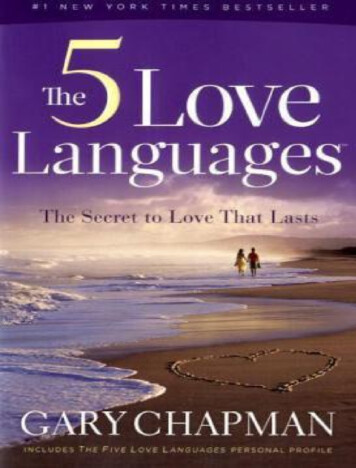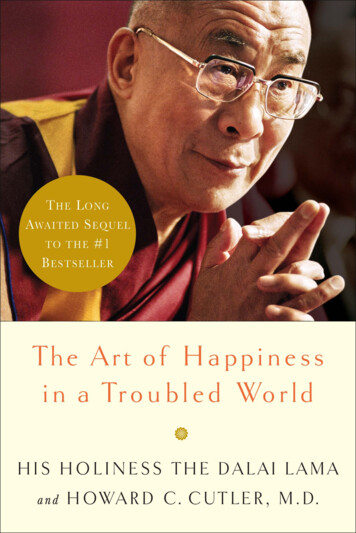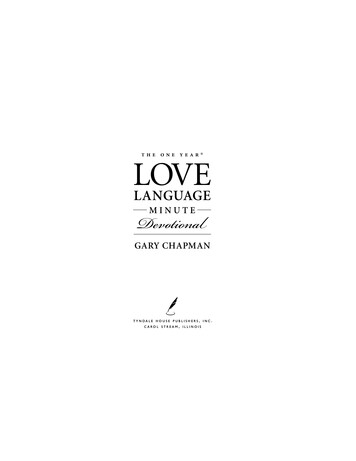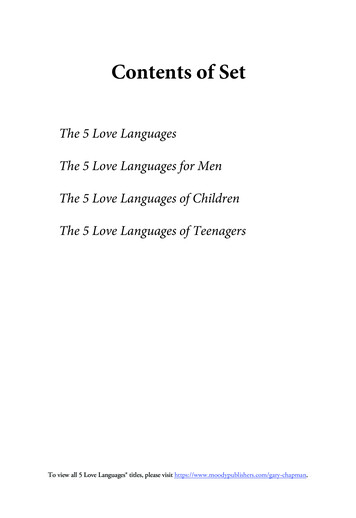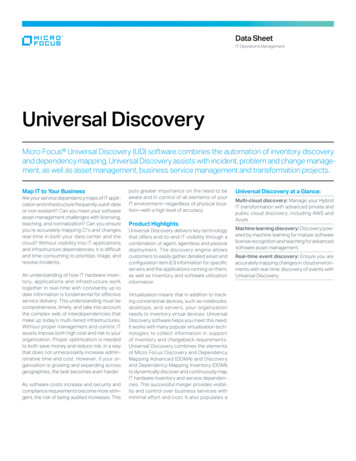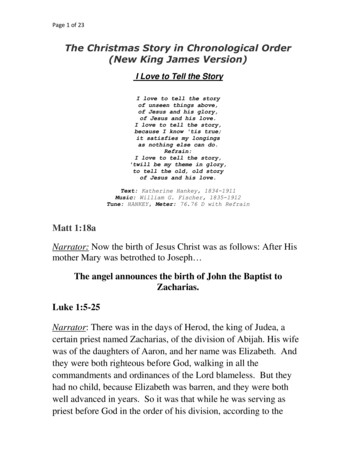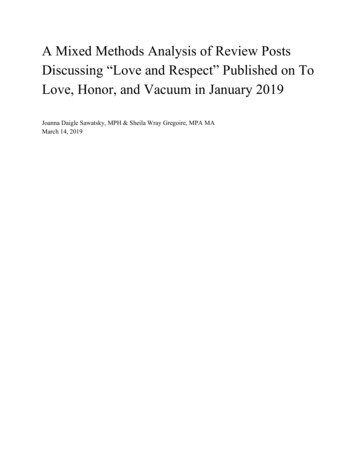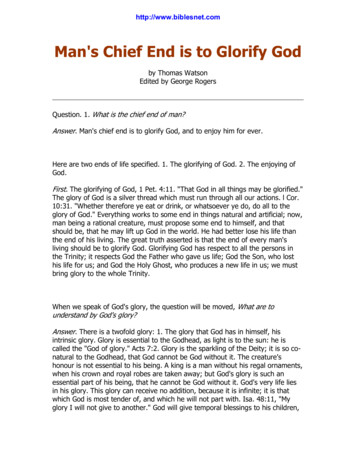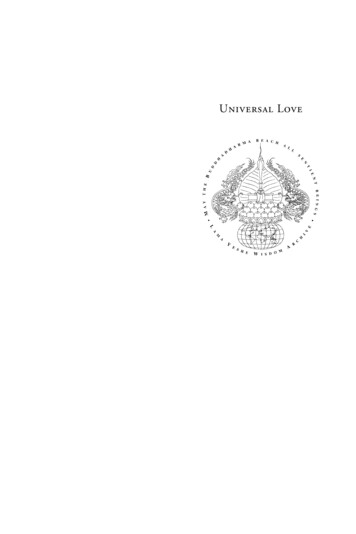
Transcription
Universal Love
Previously published by the Lama Yeshe Wisdom ArchiveBecoming Your Own Therapist, by Lama YesheAdvice for Monks and Nuns, by Lama Yeshe and Lama Zopa RinpocheVirtue and Reality, by Lama Zopa RinpocheMake Your Mind an Ocean, by Lama YesheTeachings from the Vajrasattva Retreat, by Lama Zopa RinpocheDaily Purification: A Short Vajrasattva Practice, by Lama Zopa RinpocheThe Essence of Tibetan Buddhism, by Lama YesheMaking Life Meaningful, by Lama Zopa RinpocheTeachings from the Mani Retreat, by Lama Zopa RinpocheThe Direct and Unmistaken Method, by Lama Zopa RinpocheThe Yoga of Offering Food, by Lama Zopa RinpocheThe Peaceful Stillness of the Silent Mind, by Lama YesheTeachings from Tibet, by various great lamasThe Joy of Compassion, by Lama Zopa RinpocheThe Kindness of Others, by Geshe Jampa TegchokEgo, Attachment and Liberation, by Lama YesheHow Things Exist, by Lama Zopa RinpocheFor initiates only:A Chat about Heruka, by Lama Zopa RinpocheA Chat about Yamantaka, by Lama Zopa RinpocheIn association with TDL Publications, Los Angeles:Mirror of Wisdom, by Geshe Tsultim GyeltsenIlluminating the Path to Enlightenment, by His Holiness the Dalai LamaLama Yeshe DVDs:The Three Principle Aspects of the Path Introduction to TantraOffering Hsok to Heruka Vajrasattva Anxiety in the Nuclear AgeMay whoever sees, touches, reads, remembers, or talks or thinks aboutthese books never be reborn in unfortunate circumstances, receive onlyrebirths in situations conducive to the perfect practice of Dharma, meetonly perfectly qualified spiritual guides, quickly develop bodhicittaand immediately attain enlightenment for the sake of all sentient beings.
Lama YesheUniversal LoveThe Yoga Method of Buddha MaitreyaEdited by Nicholas RibushLama Yeshe Wisdom Archive Bostonwww.LamaYeshe.comA non-profit charitable organization for the benefit of allsentient beings and an affiliate of the Foundation for thePreservation of the Mahayana Tradition. www.fpmt.org
First published 2008Lama Yeshe Wisdom ArchivePO Box 356 Weston, MA 02493, USA Lama Thubten Zopa Rinpoche 2008Please do not reproduce any part of this book by anymeans whatsoever without our permissionLibrary of Congress Cataloging-in-Publication DataThubten Yeshe, 1935–1984.Universal love : the yoga method of Buddha Maitreya /Lama Yeshe ; edited by Nicholas Ribush.p. cm.Includes bibliographical references.isbn 1-891868-19-5 (alk. paper)1. Maitreya (Buddhist deity) 2. Tantric Buddhism—Rituals.I. Ribush, Nicholas. II. Title.bq4690.m33t58 2008294.3'4436—dc22200704654510 9 8 7 6 5 4 3 2 1Cover photograph of Lama Yeshe by Carol Royce-WilderOther cover pictures courtesy Maitreya ProjectAll other Lama Yeshe photos by Carol Royce-WilderDrawing of Maitreya in Tushita on page 49 by Lama Zopa RinpocheDesigned by Gopa&Ted2 Inc.Printed in the USA with environmental mindfulness on 50 PCW recycled paper.The following resources have been saved: 38 trees, 1,761 lbs. of solid waste, 13,716gallons of water, 3,304 lbs. of greenhouse gases and 26 million BTUs of energy.Please contact the Lama Yeshe Wisdom Archivefor more copies of this and our free books
ContentsEditor’s IntroductionPart : Introduction to Buddhism . What is Buddhism? . The Purpose of Meditation . Compassion and Emptiness Part : The Yoga Method of Buddha Maitreya . A Brief History of Maitreya Buddha . The Practice of Tantra . The Preliminaries . Meditation on Emptiness . Becoming Maitreya . Meditation on Maitreya . Concluding Practices . Retreat . Questions and answers Appendices . An Explanation of the Shunyata Mantraand a Meditation on Emptiness . The Sadhana of Buddha Maitreya
viUniversal Love . The Mantra of Maitreya Buddha’s Promise . A Glance Meditation on All the Important Pointsof the Lam-rim . Chronology Glossary Bibliography
Publisher’s AcknowledgmentsWe are extremely grateful to our friends and supporters whohave made it possible for the Lama Yeshe Wisdom Archive toboth exist and function: to Lama Yeshe and Lama Zopa Rinpoche, whosekindness is impossible to repay; to Peter and Nicole Kedge and VenerableAilsa Cameron for their initial work on the Archive; to Venerable RogerKunsang, Lama Zopa’s tireless assistant, for his kindness and consideration; and to our sustaining supporters: Barry & Connie Hershey, JoanHalsall, Roger & Claire Ash-Wheeler, Claire Atkins, Thubten Yeshe,Richard Gere, Doren & Mary Harper, Tom & Suzanne Castles, LilyChang Wu and Hawk Furman.We are also deeply grateful to all those who have become members ofthe Archive over the past few years. Details of our membership programmay be found at the back of this book, and if you are not a member, pleasedo consider joining up. Due to the kindness of those who have, we nowhave three editors working on our vast collection of teachings for the benefit of all. We have posted our list of individual and corporate memberson our Web site, www.LamaYeshe.com. We also thank Henry & Catherine Lau and S. S. Lim for their help with our membership program inSingapore and Serina Yap for her help with our membership program inMalaysia. Thank you all so much for your foresight and kindness.In particular, we thank Peter Kedge and the Maitreya Project forkindly commissioning and funding the preparation and publication ofthis book, and Doss McDavid for a generous donation that has allowedus to expand the originally planned volume with additional introductory material.Furthermore, we would like to express our appreciation for the kindness and compassion of all those other generous benefactors who have
viiiUniversal Lovecontributed funds to our work since we began publishing free books.Thankfully, you are too numerous to mention individually in this book,but we value highly each and every donation made to spreading theDharma for the sake of the kind mother sentient beings and now paytribute to you all on our Web site. Thank you so much.Finally, I would like to thank the many kind people who have askedthat their donations be kept anonymous; my wife, Wendy Cook, for herconstant help and support; our dedicated office staff, Jennifer Barlow andSonal Shastri; Ven. Ailsa Cameron for her decades of meticulous editing;Ven. Thubten Labdron (Trisha Donnelly) for her help with archivingand editing; Ven. Bob Alcorn for his incredible work on our Lama YesheDVDs; David Zinn for his digital imaging expertise; Veronica Kaczmarowski and Evelyn Williames, FPMT Australia & Mandala Books (Brisbane), for much appreciated assistance with our distribution in Australia;Dennis Heslop, Philip Bradley, Mike Gilmore and our other friends atWisdom Books (London) for their great help with our distribution inEurope; our volunteer transcribers; and Greg Sneddon, Dr. Su Hungand Anne Pottage in Australia and Jonathan Steyn in London for theirhelp with our audio work.If you, dear reader, would like to join this noble group of open-heartedaltruists by contributing to the production of more books by Lama Yesheor Lama Zopa Rinpoche or to any other aspect of the Lama Yeshe Wisdom Archive’s work, please contact us to find out how. Dr. Nicholas RibushThrough the merit of having contributed to the spread of the Buddha’steachings for the sake of all sentient beings, may our benefactorsand their families and friends have long and healthy lives,all happiness, and may all their Dharmawishes be instantly fulfilled.
Editor’s IntroductionWe are delighted to add to our collection of Lama Yeshe booksand Wisdom Publications’ series of Lama Yeshe’s tantric commentaries by publishing Lama Yeshe’s teachings on the yoga method ofMaitreya, which he taught at Maitreya Institute, Holland, in 1981.Buddha Maitreya was very dear to Lama Yeshe’s heart. As well as giving this commentary on the yoga method Lama also taught two of Maitreya’s five famous texts: Dharmadharmatavibhanga (Discrimination ofPhenomena and the Nature of Phenomena) and Madhyantavibhanga (Discrimination of the Middle Way and the Extremes). And of course, Lamainitiated the Maitreya Project, the building in India of a five-hundredfoot statue of Maitreya, more information about which can be found atthe back of this book.Thus we were delighted when the Maitreya Project commissioned usto publish this book. When we had finished the first draft we realizedthat publishing Lama’s commentary alone would make the book relatively inaccessible to people unfamiliar with tantra, so we decided to addsome introductory lectures from Lama’s 1975 teachings in the USA. Nowthe book has something for everybody and better introduces the generalreader to Lama’s unique teachings on tantra.However, as Lama has taken pains to point out before: “ a wordof caution to the intellectual. Reading tantric teachings on your own,without the power of the appropriate initiation, is just an intellectualpastime—only by practicing correctly, under the guidance of a fullyIntroduction to Tantra, Becoming Vajrasattva, Bliss of Inner Fire and Becoming the Compassion Buddha. An FPMT center in Holland, see www.maitreya.nl See footnote 12, page 46, for the names of all five texts.
xUniversal Lovequalified and experienced teacher, can you evolve beyond the intellect,beyond conceptual thought into the true wisdom of a pure, spontaneous being. I am not trying to be mysterious or exclusive here but simplysaying that if you think that you can understand, let alone experience,the methods of tantric yoga merely by reading books, you are deceivingyourself—like a terminally ill person doctoring himself with the samemethods that made him ill in the first place.” In other words, simply reading books about tantra does not qualify usto practice it. For that, we need initiation and qualified guidance. So thequestion then arises, why publish books on tantra? It’s true that in timespast such teachings were secret and not made available to non-initiates.Things today are different. So many books on tantra are being publishedby so many unqualified authors that no less an authority than His Holiness the Dalai Lama has said that teachings that once would have beenkept secret should now be published in order to correct mistakes madeby inauthentic writers.That said, Lama does tell the Maitreya students, “In the future, in myabsence or that of another teacher, I think it would be good for MaitreyaInstitute to organize retreats on this yoga method. Personally, I also thinkit would be all right for people who have not had the initiation to joinsuch retreats. Because this is Maitreya Institute we can make the exception that people can practice Maitreya without initiation. There wouldbe many benefits from that. In Tibet we also had a system where peoplewithout initiation could join a group deity yoga retreat but could notdo the practice individually.” So, thanking Wendy Cook and Jennifer Barlow for their kind andhelpful editorial suggestions, I hope you enjoy Lama’s teachings in thisbook and are inspired to go deeply into the practice, find a fully qualifiedteacher like Lama himself, and quickly reach your ultimate mental andspiritual potential, enlightenment, for the benefit of all beings. From Prologue: Intellectuals, Beware! Becoming Vajrasattva, page 5.See page 102.
Part Introduction to Buddhism
. What is Buddhism?It’s difficult to say “Buddhism is this, therefore it should be likethat” or to summarize it in a simplistic way because people have a widevariety of views of what Buddhism is. However, I can say that Buddhismis not what most people consider to be a religion.First of all, when we study Buddhism we’re studying ourselves—thenature of our body, speech and mind—the main emphasis being on thenature of our mind and how it works in everyday life. The main topic isnot something else, like what is Buddha, what is the nature of God orthings like that.Why is it so important to know the nature of our own mind? It’sbecause we all want happiness, enjoyment, peace and satisfaction andthese experiences do not come from ice cream but from wisdom andthe mind. Therefore we have to understand what the mind is and howit works.One thing about Buddhism is that it’s very simple and practical in thatit explains logically how satisfaction comes from the mind and not fromsome kind of supernatural being in whom we have to believe.I understand that this idea can be difficult to accept because in theWest, from the moment you’re born, there’s extreme emphasis on thebelief that the source of happiness resides outside of yourself in external objects. Therefore your sense perception and consciousness have analmost fanatical orientation toward the sense world and you come tovalue external objects above all else, even your life. This extreme viewthat over-values material things is a misconception, the result of unreasonable, illogical thought.Therefore, if you want true peace, happiness and joy, you need torealize that happiness and satisfaction come from within you and stop
4Universal Lovesearching so obsessively outside. You can never find real happiness outthere. Whoever has?From the moment they evolved, humans have never found true happiness in the external world, even though modern scientific technologyseems to think that that’s where the solution to human happiness lies.That’s a totally wrong conception. Of course, technology is necessary andgood, but it has to be used skillfully. Religion is not against technologynor is external development contrary to the practice of religion, eventhough we do find religious extremists who oppose material development and scientific advancement and non-believers pitted against thosewho believe. All such fanatics are wrong.First, however, let me ask a question. Where in the world can we findsomebody who doesn’t believe? Who among us is a true non-believer?In asking this I’m not necessarily referring to conceptual belief. Theperson who says “I don’t believe” thinks he’s intellectually superior butall you have to do to puncture his pride is ask a couple of simple questions: “What do you like? What don’t you like?” He’ll come up with ahundred likes and dislikes. “Why do you like those things? Why don’tyou like the others?” Questions like those immediately expose all of usto be believers.Anyway, to live in harmony we have to balance external and internaldevelopment; failure to do so simply leads to mental conflict and restless states of mind.So Buddhism finds no contradiction in advocating external scientificand inner mental development; both are correct but, depending on mental attitude, each can be positive or negative as well. There’s no such thingas absolute, eternally existent, total positivity or absolute, eternally existent, total negativity. Positive and negative actions are defined mainly bythe motivation that gives rise to them not by the actions themselves.Therefore it’s very important to avoid extreme views; extreme emotional attachment to sense objects—“This is good; this makes mehappy”—only leads to mental illness. What we need to learn instead ishow to remain in the middle, between the extremes of exaggeration andunderestimation.That doesn’t mean giving everything up. You don’t have to get rid of
What is Buddhism? 5all your possessions. It’s extreme emotional attachment to any object—external or internal—that makes you mentally ill; that’s what you haveto abandon. Western medicine has few answers to that kind of sickness.There’s nothing you can take; it’s very hard to cure. Psychologists, psychiatrists, therapists I doubt that they can solve the problems of attachment. Most of you have probably experienced that. Attachment and thelack of knowledge-wisdom that underlies it are the actual problem.The reason that Western health professionals can’t treat attachmenteffectively is that they don’t know how to investigate the reality of themind. The function of attachment is to bring frustration and misery. Weall know this; it’s not that difficult to grasp—in fact, it’s rather simple.But Buddhism has a method of revealing the psychology of attachmentand how it works in everyday life. That method is meditation.Excessive concern for your own comfort and pleasure driven by theexaggerations of attachment automatically leads to feelings of hatred forothers. These two incompatible feelings—attachment and hatred—naturally clash in your mind. From the Buddhist point of view, a mind inthis kind of conflict is sick and unbalanced.Going to church or temple once a week is not enough to deal withthis—you have to examine your mind all day long every day and maintain constant awareness of the way you speak and act. We usually hurtothers unconsciously. In order to observe the actions of our unconsciousmind we need to develop powerful wisdom energy, but that’s easier saidthan done; it takes work to be constantly aware of what’s going on inthe mind.Most religious and non-religious people agree that loving kindnessfor others is important. How do we develop loving kindness? First wehave to understand how and why others suffer, what the best kind ofhappiness for them to have is, and how they can get it. That’s what wehave to investigate. But our emotions get the better of us. We projectour attachments onto others. We think that others like the same thingswe do, that people’s main problems are hunger and thirst and that foodand water are the solution. The human problem is not hunger and thirst;it’s misconception and mental pollution.Therefore it’s very important that you make your mind clear. If you
6Universal Lovecan, the ups and downs of the external world won’t bother you; no matter what happens out there, your mind will remain peaceful and joyous.If you get too caught up in watching the up and down world you finishup going up and down yourself: “Oh, that’s so good! Oh, that’s so bad!”If the outer world is your only source of happiness, its natural fluctuations constantly disturb your peace of mind and you can never be happy,no matter how long you live. It’s impossible.But if you understand that the world is up and down by nature andexpect things to fluctuate, you won’t get upset when they do and as aresult your mind will be balanced and peaceful. Whenever your mind isbalanced and peaceful you have wisdom and control.Perhaps you think, “Oh, control! Buddhism is all about control. Whowants control? That’s a Himalayan trip, not a Western one.” But in ourexperience, control is natural. When you have the wisdom that knowshow the uncontrolled mind functions and where it comes from, controlcomes naturally.All people have equal potential to control and develop their mind.There’s no distinction according to race, color or nationality. Equally,all can experience mental peace and joy. Human ability is great—if youuse it with wisdom, it’s worthwhile; if you use it with ignorance andemotional attachment, you waste your life. Therefore, be careful. LordBuddha’s teaching strongly emphasizes understanding over the hallucinated fantasies of the ordinary mind. The emotional projections andhallucinations that arise from unrealistic perceptions are wrong conceptions and as long as your mind is polluted by wrong conceptions youwill always be frustrated.The clean clear mind is simultaneously joyful. That’s simple to see.When your mind is under the control of extreme attachment on oneside and extreme hatred on the other, you have to examine it to see whyyou grasp at happiness and why you hate. When you check your objectsof attachment and hatred logically, you’ll see that the fundamental reason for these contrary emotions is basically the same thing: emotionalattachment projects a hallucinatory object; emotional hatred projects ahallucinatory object. And either way, you believe in the hallucination.As I said before, it’s not an intellectual, “Oh, yes, I believe.” And by
What is Buddhism? 7the way, just saying you believe in something doesn’t actually mean youdo. However, belief has deep roots in your subconscious and as long asyou’re under the influence of attachment, you’re a believer. Belief doesn’tnecessarily have to be in something supernatural or beyond logic. Thereare many ways to believe.From the standpoint of Buddhist psychology, in order to have loveand compassion for all living beings you first have to develop equilibrium—a feeling that all beings are equal. This is not a radical sort of “Ihave a piece of candy; I need to cut it up and share it with everybodyelse” but rather something you have to work with in your mind. A mindout of balance is an unhealthy mind.So equalizing sentient beings is not something we do externally; that’simpossible. The equality advocated by Buddhists is completely differentfrom that which the communists talk about; ours is the inner balancederived from training the mind.When your mind is even and balanced you can generate loving kindness for all beings in the universe without discrimination. At the sametime, emotional attachment automatically decreases. If you have theright method, it’s not difficult; when right method and right wisdomcome together, solving problems is easy.But we humans suffer from a shortage of intensive knowledge-wisdom. We search for happiness where it doesn’t exist; it’s here, but we’relooking over there. It’s actually very simple. True peace, happiness andjoy lie within you and if you meditate correctly and investigate thenature of your mind you can discover the everlasting happiness andjoy within. They’re always with you; they’re mental energy, not externalmaterial energy, which always fizzles out. Mental energy coupled withright method and right wisdom is unlimited and always with you. That’sincredible! And it explains why human beings are so powerful.Materialists think that people are powerful because of the amazingbuildings and so forth that they construct but all that actually comes fromthe human mind. Without the skill of the human mind there’s no external supermarket. Therefore, instead of placing extreme value on regularsupermarkets we should try to discover our own internal supermarket.That’s much more useful and leads to a balanced, even mind.
8Universal LoveAs I mentioned before, it can sound as if Buddhism is telling you torenounce all your possessions because attachment is bad, but renunciation isn’t a physical giving up. You go to the toilet every day but thatdoesn’t mean you’re attached to it—you’re not attached to your toilet,are you? We should have the same attitude to all the material thingswe use—give them a reasonable value according to their usefulness forhuman existence, not an extreme one.If a kid runs crazily over dangerous ground to get an apple, trips, fallsand breaks his leg, we think he’s foolish, exaggerating the value of theapple and putting his wellbeing at risk for the sake of achieving a tinygoal. But actually, we’re the same. We exaggerate the beauty of objectsof desire and generate extreme attachment toward them, which blindsus to our true potential. This is dangerous; we’re just like the boy whorisks his safety for an apple. By looking at objects with emotional attachment and chasing that hallucinated vision we definitely destroy our purepotential.Human potential is great but we have to use our energy skillfully; wehave to know how to put our lives in the right direction. This is extremelyimportant.Now, instead of just talking, let me try to answer any questions youmight have.Q. How can I make my mind aware so that I have equilibrium of mindand skillfulness of action?Lama. The first thing you need to do is to recognize how your unbalancedmind works—how it arises, what causes it to do so, what it reacts to andso forth—and how your false conceptions create the view you perceive.This recognition allows you to put your mind into a clearer atmosphere.Once you understand your unbalanced mind, it becomes clear.The Buddhist approach to negativity is not to avoid it but to confrontit head-on and check why it’s there, what its reality is and so forth. Wethink that this is the best foundation for destroying the negative mindand is much more logical and scientific than just avoiding it—like running away to some other place or trying to think only positive things.
What is Buddhism? 9That’s not enough. So, when problems arise, instead of turning away starethem right in the face. That’s very useful; that’s the Buddhist way.If you run from problems you can never really ascertain their root.Putting your head in the sand doesn’t help. You have to determine wherethe problem comes from and how it arises. The way to discover the cleanclear mind is to understand the nature of the unclear mind, especially itscause. If there’s a thorn bush growing at your door, scratching you everytime you go in or out, pruning it won’t be enough to solve the problemonce and for all—you have to pull it out by the root. Then it will neverbother you again.Q. You mentioned going beyond thought. Could you please talk aboutthat experience?Lama. It’s possible. When you suddenly realize that the hallucinated selfimagination projected by your ego does not exist as it appears, you canbe left with an automatic experience of emptiness, a vision of shunyata.But as long as your self-imagination—“I’m Thubten Yeshe, I’m this, I’mthat, therefore I should have this, I should do that”—continues to runamok, it’s impossible to go beyond thought. You need to investigatesuch thoughts with skillful, analytic knowledge-wisdom. Scrutinize yourmind’s self-imagination as interpreted by your ego: what am I? What is it?Is it form? Does it have color? No. Then what is it? The only conclusionyou can eventually arrive at is that it does not exist anywhere, either externally or internally, and the vision that automatically accompanies thatexperience is one of emptiness; at that time you reach beyond thought.Before that, your mind was full of “I’m this, therefore I need a house; I’mthat, therefore I need a car; I’m the other, therefore I need to go to thesupermarket.” All your “I’m that-this” comes from conflicted emotionalthought that completely destroys your inner peace .Q. So then you’re beyond thought and there’s the void, emptiness?Lama. Yes, that’s emptiness or, in Sanskrit terminology, shunyata. Butemptiness does not mean nothingness. It refers to an absence of egoconceptualization—“I am Thubten Yeshe”—which is bigger than LosAngeles but a complete hallucination. When we realize that it’s totally
10Universal Lovenon-existent, that it’s only projected by the mind, by the ego, theexperience of shunyata suddenly arises; at that time there’s an absenceof thought.Now, “no thought” does not mean that you become somehow unconscious. Many people think that that’s what it means but that’s dangerous.Reaching beyond thought means eliminating the usual conflict-producing, dualistic, “that-this” type of thought, not lapsing into unconsciousness.Q. Does Buddhism have physical exercises similar to tai chi or yoga, totone the body as well as the mind? Are there physical exercises that area part of Buddhism?Lama. Physical exercise is good but mental exercise is better; it’s morepowerful. Nevertheless, we do have certain exercises but they’re mainlyto facilitate sitting meditation. Sometimes we do retreat in a small roomfor months at a time; on such occasions we also do some physical yoga.However, we normally emphasize that, no matter what actions we engagein with our body, speech and mind, mental attitude is the most important thing. Buddhism always stresses the importance of understandingthe nature of the mind.Q. How do we get rid of mental pollution?Lama. By realizing how the mind is polluted, where the pollution comesfrom and that it has a deep root. If you know that, you can get rid of it; ifyou don’t, you can’t. Thus Lord Buddha always emphasized understanding as the only path to liberation, that the only way to attain liberationis through understanding.Q. If everything is so simple and God is so perfect, why did he create allthe negativity and suffering we see in the world today?Lama. Perhaps it’s you who created all the bad things you say God did.Our own mind creates our own uncontrolled situation. All the suffering we see in the world today was not created by God but by the negative mind.
What is Buddhism? 11Q. How can I escape the cycle of death and rebirth?Lama. By recognizing and destroying that which causes you to cycle.Basically, if you’re free of emotional attachment there’s no cycle of deathand rebirth. Once you cut emotional attachment, the cause, there’s noreason to ever again have to experience an uncontrolled situation, theresult. The short answer: cut attachment.Q. When I read Zen and other Eastern philosophies, they all seem to besaying the same thing.Lama. Yes, if you examine the different religions more deeply with rightunderstanding, you’ll find the same qualities, but if you just check themsuperficially you’re more likely to be judgmental: “This religion’s good;that one’s bad.” That’s a poor assessment. What you need to look at isthe purpose of each religion—every religion has a purpose—and howthat purpose can be realized in experience.The question is, however, do followers of a given religion know how toput its ideas into action? This is often the problem. People might thinka religion’s ideas are good but they don’t have the key of method; theydon’t know how to put those ideas into experience.Q. Then are you saying that your way of putting ideas into action is better than the others?Lama. No, I’m not saying that my way is the best and that the others arewrong. I’m saying that most of us lack that knowledge. For example, youmight say, “I’m a Buddhist,” but if you check how much you understandyour religion, how much you act in accordance with its principles, perhaps even though you say, “I’m a Buddhist,” you’re not.I’m not talking about any specific person; I’m talking about all of us.So the most important thing to know is the method: how to bring loftyideas down to the practical level, into our life.Q. Lama, do you have anything to say regarding the
the methods of tantric yoga merely by reading books, you are deceiving yourself—like a terminally ill person doctoring himself with the same methods that made him ill in the fi rst place.” In other words, simply reading books about tantra does not qualify us to practice it. Fo
